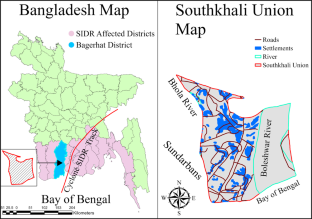Natural Hazards ( IF 3.7 ) Pub Date : 2024-04-21 , DOI: 10.1007/s11069-024-06584-3 Md. Kamruzzaman , G. M. Harun-Or-Rashid , Mithun Chakrabartty , Juan Jose Castro

|
Post occupancy evaluation of housing reconstruction after a disaster is imperative for every nation that pushes ahead the idea of disaster resilient housing, which is obligatory for the social, cultural, and economic growth of a society or a country. Cyclone SIDR is the most dreadful of all catastrophes that have struck Bangladesh and aftermath of this devastation, a number of donor organizations stepped forward to help disaster victims by providing housing solutions. The aim of this study is to effectiveness analysis of these housing reconstruction programs from planning and construction standpoints with a post occupancy framework. Based on three months of detailed field survey at the most devastated location of cyclone SIDR, Southkhali Union (small rural area) of Sarankhola Upazila (sub-district) of Bagerhat District, this research infers that the donor organizations didn’t pay much attention in terms of choice, need and indigenous practices to provide reconstructed houses for the target beneficiaries. The study found that about 78% of the reconstructed houses hold dissatisfaction of the beneficiaries. As a result, people prompt to transform or modify 54% of the ‘Donor Driven’ houses soon after completion of the project. Another 16% donor driven house remained abandoned and rest 8% demolished. On the other hand, ‘Owner Driven’ houses were functionally perfect. They had freedom to build their houses with locally available natural materials with resilient planning and construction features which reduces disaster vulnerability and sustains for long time in comparison with donor driven houses.
中文翻译:

热带气旋“sidr”后住房重建的入住后评估
对于每一个推行抗灾住房理念的国家来说,灾后住房重建的入住后评估都是势在必行的,这是一个社会或国家的社会、文化和经济发展的义务。气旋 SIDR 是袭击孟加拉国的所有灾难中最可怕的一次,这场灾难发生后,许多捐助组织挺身而出,通过提供住房解决方案来帮助灾民。本研究的目的是从规划和建设的角度以及入住后框架对这些住房重建计划进行有效性分析。根据对 SIDR 气旋受灾最严重的巴格哈特区 Sarankhola Upazila(街道)的 Southkhali Union(小农村地区)进行了三个月的详细实地调查,本研究得出结论,捐助机构并未给予足够的重视。为目标受益人提供重建住房的选择条件、需要和当地做法。研究发现,约78%的重建房屋受益人表示不满意。因此,人们在项目完成后不久就敦促对 54% 的“捐助驱动”房屋进行改造或改造。另外 16% 的捐赠房屋仍然被遗弃,其余 8% 被拆除。另一方面,“业主驱动”的房屋在功能上是完美的。他们可以自由地使用当地可用的天然材料建造房屋,并具有弹性规划和施工特点,与捐赠驱动的房屋相比,可以减少灾害脆弱性并维持较长时间。



























 京公网安备 11010802027423号
京公网安备 11010802027423号